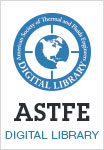
ISSN Online: 2379-1748
8th Thermal and Fluids Engineering Conference (TFEC)
BUBBLE NUCLEATION AND DEPARTURE IN CRYOGENIC ANNULAR FLOWS − AN EXPERIMENTAL INVESTIGATION
Аннотация
The present research presents a novel annular flow cooling arrangement for superconducting transformers. This arrangement optimizes thermal efficiency by minimizing cryogen boil off and provides a basis for industrial use of superconductors in high current devices. The study isolated heat transfer mechanisms by measuring flux contributions through a Yttrium Boron Cuprate Oxide [YBCO] ribbon, copper terminations, and tube walls. Accurate mass measurements with the conductor under various load conditions provided an experimentally validated relationship between heat loss and electrical power. A bubble visualization platform was constructed using two concentric beakers with a nitrogen purge gas insulating the intermediate volume. A single YBCO superconducting ribbon was fixed horizontally between copper terminations and immersed in liquid nitrogen to view bubble formation. Variable AC power installed across the terminations provided steady state current up to the superconductor maximum rating. Bubble frequency, and boil-off were measured experimentally, and the values compared to analytical models across a range of conductor currents. Despite its near-zero resistance to DC currents, YBCO material experiences hysteresis and eddy current losses during AC operation[1]. Bubbles forming and combining on the superconductor lead to surface temperatures above the critical temperature of 85K[2]. These hot spots ultimately cause failure of the superconductor in a phenomenon known as quenching. The experimental data captured in this research may be used to optimize cryogen flow, thus mitigating the risk of quenching while simultaneously minimizing nitrogen boil off to achieve maximum net efficiency. Isolating and quantifying relative heat flux contributions provides engineering guidance for future study and efficiency improvement. Critically, the highest risks of quenching are not driven by current or high heat flux, but instead by highly localized bubble formation at the boundary between conventional and superconducting materials. This provides a basis for future work.